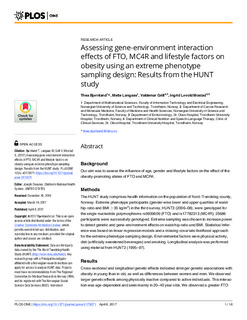| dc.contributor.author | Bjørnland, Thea | |
| dc.contributor.author | Langaas, Mette | |
| dc.contributor.author | Mostad, Ingrid Løvold | |
| dc.contributor.author | Grill, Valdemar Erik Robert | |
| dc.date.accessioned | 2017-05-03T11:49:26Z | |
| dc.date.available | 2017-05-03T11:49:26Z | |
| dc.date.created | 2017-04-07T11:38:12Z | |
| dc.date.issued | 2017 | |
| dc.identifier.issn | 1932-6203 | |
| dc.identifier.uri | http://hdl.handle.net/11250/2441531 | |
| dc.description.abstract | Background
Our aim was to assess the influence of age, gender and lifestyle factors on the effect of the obesity-promoting alleles of FTO and MCR4.
Methods
The HUNT study comprises health information on the population of Nord-Trøndelag county, Norway. Extreme phenotype participants (gender-wise lower and upper quartiles of waist-hip-ratio and BMI ≥ 35 kg/m2) in the third survey, HUNT3 (2006–08), were genotyped for the single-nucleotide polymorphisms rs9939609 (FTO) and rs17782313 (MC4R); 25686 participants were successfully genotyped. Extreme sampling was chosen to increase power to detect genetic and gene-environment effects on waist-hip-ratio and BMI. Statistical inference was based on linear regression models and a missing-covariate likelihood approach for the extreme phenotype sampling design. Environmental factors were physical activity, diet (artificially sweetened beverages) and smoking. Longitudinal analysis was performed using material from HUNT2 (1995–97).
Results
Cross-sectional and longitudinal genetic effects indicated stronger genetic associations with obesity in young than in old, as well as differences between women and men. We observed larger genetic effects among physically inactive compared to active individuals. This interaction was age-dependent and seen mainly in 20–40 year olds. We observed a greater FTO effect among men with a regular intake of artificially sweetened beverages, compared to non-drinkers. Interaction analysis of smoking was mainly inconclusive.
Conclusions
In a large all-adult and area-based population survey the effects of obesity-promoting minor-alleles of FTO and MCR4, and interactions with life style factors are age- and gender-related. These findings appear relevant when designing individualized treatment for and prophylaxis against obesity. | nb_NO |
| dc.language.iso | eng | nb_NO |
| dc.publisher | Public Library of Science | nb_NO |
| dc.rights | Navngivelse 4.0 Internasjonal | * |
| dc.rights.uri | http://creativecommons.org/licenses/by/4.0/deed.no | * |
| dc.title | Assessing gene-environment interaction effects of FTO, MC4R and lifestyle factors on obesity using an extreme phenotype sampling design: Results from the HUNT study | nb_NO |
| dc.type | Journal article | nb_NO |
| dc.type | Peer reviewed | nb_NO |
| dc.source.journal | PLoS ONE | nb_NO |
| dc.identifier.doi | 10.1371/journal.pone.0175071 | |
| dc.identifier.cristin | 1464331 | |
| dc.description.localcode | © 2017 Bjørnland et al. This is an open access article distributed under the terms of the Creative Commons Attribution License, which permits unrestricted use, distribution, and reproduction in any medium, provided the original author and source are credited. | nb_NO |
| cristin.unitcode | 194,63,15,0 | |
| cristin.unitcode | 194,65,15,0 | |
| cristin.unitname | Institutt for matematiske fag | |
| cristin.unitname | Institutt for kreftforskning og molekylær medisin | |
| cristin.ispublished | true | |
| cristin.fulltext | original | |
| cristin.qualitycode | 1 | |

